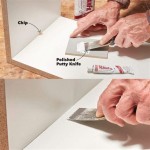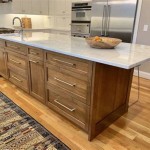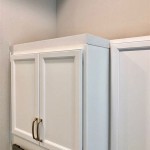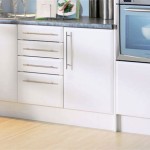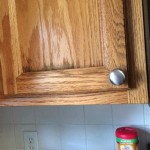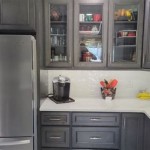Transforming Kitchen Cabinets with Chalk Paint: A Comprehensive Guide
Chalk paint, renowned for its matte finish, ease of application, and versatility, has become a popular choice for DIY enthusiasts and homeowners seeking a cost-effective way to refresh their kitchen cabinets. Unlike traditional paints, chalk paint often requires minimal surface preparation, adheres well to various materials, and offers a unique aesthetic that can complement a wide range of kitchen styles. This article provides a comprehensive guide to using chalk paint on kitchen cabinets, covering the necessary preparation, application techniques, and protective finishing steps for a durable and visually appealing result.
The decision to utilize chalk paint for kitchen cabinets hinges on several factors. Its ability to adhere to most surfaces, including wood, laminate, and even metal, without extensive priming is a significant advantage. The matte finish creates a soft, vintage-inspired look, which is particularly well-suited for farmhouse, cottagecore, and shabby chic design schemes. Moreover, chalk paint's inherent opacity allows for excellent coverage, often requiring fewer coats compared to other types of paint. However, it's essential to consider the durability of chalk paint, as it is inherently porous and susceptible to staining and water damage if not properly sealed. The subsequent sealing process is crucial for ensuring the longevity and cleanability of the painted cabinets.
Preparation: Laying the Foundation for a Successful Project
Proper preparation is paramount to achieving a professional and lasting finish when using chalk paint on kitchen cabinets. This phase ensures optimal adhesion, minimizes imperfections, and ultimately contributes to the overall success of the project. The preparation process involves several key steps:
Cleaning: The initial step involves thoroughly cleaning the cabinet surfaces to remove grease, grime, and any existing coatings. A degreasing cleaner, such as trisodium phosphate (TSP) or a commercially available kitchen cleaner, is recommended. All surfaces must be scrubbed thoroughly and rinsed with clean water. Allow the cabinets to dry completely before proceeding.
Sanding (Optional): While chalk paint often adheres well without extensive sanding, lightly sanding the cabinet surfaces can improve adhesion, particularly if the existing finish is glossy or slick. Use a fine-grit sandpaper (220-grit or higher) to gently scuff the surface, creating a slightly roughened texture. This provides a better grip for the chalk paint. Remove any sanding dust with a tack cloth or a damp cloth.
Removing Hardware: All knobs, pulls, hinges, and other hardware should be removed from the cabinet doors and drawer fronts. This allows for easier painting and prevents paint from getting on the hardware. Store the hardware in a safe place to avoid losing any pieces.
Taping and Covering: Use painter's tape to mask off any areas that should not be painted, such as the inside edges of cabinet frames, walls, or countertops. Cover countertops, floors, and appliances with drop cloths or plastic sheeting to protect them from paint splatters.
Priming (Optional): While chalk paint often adheres well without a primer, certain situations may warrant the use of a primer. If the cabinets are made of bare wood, especially if it is a type that is prone to tannin bleed-through (e.g., oak or cherry), a stain-blocking primer can prevent discoloration of the chalk paint. Similarly, if the existing finish is particularly dark or heavily stained, a primer can help to block the tannins and ensure even coverage. Apply the primer according to the manufacturer's instructions and allow it to dry completely before proceeding with the chalk paint application.
Application: Techniques for Achieving a Smooth Finish
The application of chalk paint requires careful attention to detail to achieve a smooth, even finish. The choice of application method, the number of coats applied, and the drying time between coats all contribute to the final result. Here's a breakdown of the key steps involved in applying chalk paint to kitchen cabinets:
Choosing the Right Tools: Two primary tools are commonly used for applying chalk paint: paintbrushes and foam rollers. Paintbrushes are ideal for achieving a textured, rustic look, as they leave visible brushstrokes. Foam rollers, on the other hand, provide a smoother, more uniform finish. Choose the tool that best suits the desired aesthetic.
Applying the First Coat: Dip the paintbrush or roller into the chalk paint, being careful not to overload it. Apply the paint in thin, even strokes, following the grain of the wood (if applicable). Avoid applying too much pressure, as this can cause the paint to drip or sag. Work in small sections, overlapping each stroke slightly to ensure complete coverage. Allow the first coat to dry completely before proceeding to the second coat. The drying time will vary depending on the humidity and temperature, but generally, it takes at least a few hours.
Sanding Between Coats (Optional): After the first coat has dried, use a fine-grit sandpaper (320-grit or higher) to lightly sand the surface. This will smooth out any imperfections, such as brushstrokes or drips, and create a better surface for the second coat to adhere to. Remove any sanding dust with a tack cloth or a damp cloth.
Applying the Second Coat: Apply the second coat of chalk paint in the same manner as the first coat, using thin, even strokes. Again, avoid applying too much pressure and work in small sections. The second coat will provide more complete coverage and help to even out the color. Allow the second coat to dry completely before proceeding to the sealing stage.
Distressing (Optional): If you desire a distressed, vintage look, you can lightly sand the edges and corners of the cabinets after the second coat has dried. Use a medium-grit sandpaper (120-grit or 150-grit) to remove small amounts of paint, revealing the underlying wood or previous finish. Be careful not to over-sand, as this can damage the cabinets. Wipe away any sanding dust with a tack cloth or a damp cloth.
Sealing: Protecting the Painted Surface
Sealing chalk-painted kitchen cabinets is a crucial step to protect the finish from scratches, stains, and water damage. Chalk paint is inherently porous and requires a sealant to ensure its longevity and cleanability. Several types of sealants are suitable for use with chalk paint, each offering different levels of protection and aesthetic qualities. The choice of sealant will depend on the desired look and the level of durability required.
Wax: Wax is a traditional sealant for chalk paint, offering a soft, matte finish and a subtle sheen. It is relatively easy to apply and provides good protection against scratches and minor spills. However, wax is not as durable as other sealants and may require reapplication every few years. Apply the wax with a clean cloth or brush, working it into the chalk paint in a circular motion. Buff the wax with a clean cloth to create a smooth, even sheen.
Polyurethane: Polyurethane is a more durable sealant option, providing excellent protection against scratches, stains, and water damage. It is available in various sheens, from matte to glossy, allowing you to customize the look of your cabinets. Water-based polyurethanes are generally preferred over oil-based polyurethanes, as they are less likely to yellow over time. Apply the polyurethane with a brush, roller, or sprayer, following the manufacturer's instructions. Allow the polyurethane to dry completely between coats, and sand lightly with fine-grit sandpaper to smooth out any imperfections.
Acrylic Sealer: Acrylic sealers offer a good balance of durability and ease of application. They are water-based and available in various sheens. Acrylic sealers provide good protection against scratches, stains, and water damage, and they are relatively resistant to yellowing. Apply the acrylic sealer with a brush, roller, or sprayer, following the manufacturer's instructions. Allow the acrylic sealer to dry completely between coats.
Application of Sealant: Regardless of the sealant chosen, the application process involves similar steps. Ensure the chalk paint is completely dry before applying the sealant. Apply the sealant in thin, even coats, following the grain of the wood (if applicable). Avoid applying too much pressure, as this can cause the sealant to drip or sag. Allow the sealant to dry completely between coats, and sand lightly with fine-grit sandpaper to smooth out any imperfections. Apply at least two coats of sealant for optimal protection.
After the sealant has dried completely, reattach the hardware to the cabinet doors and drawer fronts. Clean the cabinets with a mild soap and water solution. Avoid using harsh chemicals or abrasive cleaners, as these can damage the finish. With proper care and maintenance, chalk-painted kitchen cabinets can provide years of beauty and functionality. The key to success lies in meticulous preparation, careful application, and the selection of a suitable sealant to protect the painted surface.

Painting Kitchen Cabinets With Chalk Paint Simply Today Life

Chalk Painted Kitchen Cabinets 2 Years Later Our Storied Home

How To Paint A Kitchen With Chalk Maison De Pax

How 500 And Some Chalk Paint Totally Transformed This Kitchen

Paint Your Kitchen Cabinets With Chalkboard Jessica Rayome

Annie Sloan Chalk Paint Kitchen Cabinets A Créé Une Peintu Painting

Why I Repainted My Chalk Painted Cabinets Sincerely Sara D Home Decor Diy Projects

Chalk Painted Kitchen Cabinets 2 Years Later Our Storied Home

Why I Repainted My Chalk Painted Cabinets Sincerely Sara D Home Decor Diy Projects

How To Paint Kitchen Cabinets White Let S Furniture
Related Posts

